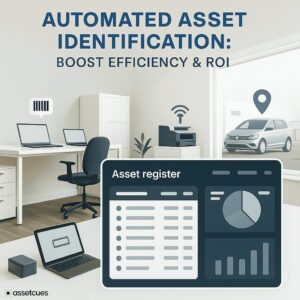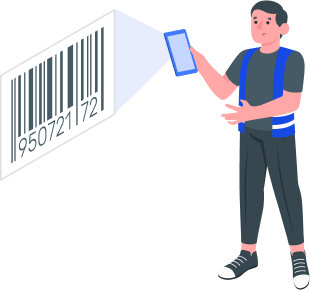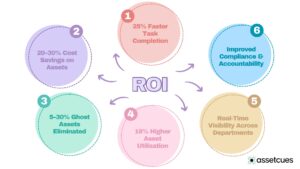Introduction
Many mid-to-large enterprises manage thousands of physical assets – from IT equipment and machinery to office furniture and vehicles. Tracking these assets manually with spreadsheets or paper logs is cumbersome and error-prone.
Explore expert tips on asset tagging — Best Practices & Implementation Guide
Automated asset identification leverages barcode and RFID tags for real-time tracking. It automates processes while maintaining a centralized register, significantly improving operational efficiency. Moreover, it enhances accuracy and directly delivers a stronger return on investment.
The asset tracking market is booming, expected to more than double by 2030 (Grand View Research). However, simply deploying new asset tagging technology isn’t a magic fix. How you implement asset identification makes the difference between real ROI and wasted budgets.
Done right, automated asset identification transforms workflows across Finance, IT, and Operations. It ensures each piece of equipment is accounted for, properly utilized, and contributing value.

What is Automated Asset Identification?
Asset identification assigns a unique ID to every organizational asset for tracking. Automated systems use barcodes or RFID chips with software, thereby avoiding manual errors. This method ensures accurate data and supports improved decision-making across every stage.
Manual identification once meant counting inventory by hand and logging serial numbers—a slow, error-prone process. Lost or mis-recorded assets could lead to wasted budget, compliance issues, or downtime when critical equipment went missing.
Automation solves these problems by using scannable tags that update records instantly whenever an asset moves or is serviced. The result is a much faster, error-resistant process.

Curious How Asset Tagging Works?
From tag placement to real-time scanning and reporting—see the full journey of smarter asset management in action.

Curious How Asset Tagging Works?
From tag placement to real-time scanning and reporting—see the full journey of smarter asset management in action.
Key Asset Identification Technologies
-
Barcodes & QR Codes:
Barcodes provide inexpensive, widely used labels for efficient asset tagging across industries. Scanning a barcode instantly retrieves the asset’s ID and essential details. QR codes, holding more data, can even link to online maintenance records. Both options remain cost-effective and simple, though they generally require line-of-sight scanning.
-
RFID Tags:
RFID tags store data on small chips and enable wireless, line-of-sight-free reading. They allow scanning multiple tagged assets within seconds, greatly accelerating inventory counts. Although more costly, RFID suits high-value or mobile assets where efficiency justifies expense.
-
GPS and BLE Trackers:
In special cases, GPS trackers or Bluetooth Low Energy (BLE) beacons are used to track assets spread over large areas. For example, they can automatically broadcast the real-time location of vehicles or heavy equipments in the field.
-
Asset Management Software (Asset Register):
A centralized asset management platform acts as the single source of truth. It stores every asset’s ID and details within one unified database. Records update in real time whenever scans occur or statuses change. This approach ensures departments consistently access accurate and up-to-date asset identification information.
Selecting the right mix of identification technologies is essential for accurate tracking. For example, offices often use barcode labels, while outdoor sites prefer RFID tags or GPS units. Therefore, automating asset identification ensures assets are consistently tracked without adding extra staff effort. You can learn more about geo-tagging in asset tracking to see how it enhances location visibility.
Benefits of Automated Asset Identification
Automating asset identification yields several key benefits that directly improve efficiency and ROI:
-
Greater efficiency & productivity:
Employees spend significantly less time searching for equipment or doing manual checks. Many companies report nearly a 25% increase in task completion after automation. Staff focus on their primary work instead of hunting assets or filling forms.
-
Cost savings:
Better tracking reduces lost, stolen, or redundant assets while optimizing inventory levels. Research shows asset tracking solutions deliver 20–30% cost savings through utilization and waste reduction. Accurate knowledge of available assets and usage prevents unnecessary purchases and potential loss.
-
Improved asset utilization & loss prevention:
Real-time visibility helps identify underused assets and redeploy them instead of purchasing extras. It eliminates ghost assets, which often represent 5–30% of some inventories. Automated identification removes phantom records and flags missing assets early to prevent theft.
-
Simplified compliance & audits:
A complete, up-to-date asset register makes audits and regulatory compliance much easier. Finance teams can quickly verify each asset’s existence, location, and value, ensuring records align with reality. Clear asset ID records provide an audit trail for accountability, so annual audits become far less stressful.
Read more to discover how IT asset tagging can help reduce losses and ensure more reliable audits

Implementing an Automated Asset Identification Process
Implementing automated asset identification in your organization requires a clear plan. Here are the key steps and best practices to guide your asset identification process:
- Audit and catalog: Inventory all fixed assets and record key details (model, serial, location, condition, etc.).
- Choose tagging methods: Select appropriate fixed asset identification tags (e.g. barcodes, RFID) to suit each asset type and environment.
- Assign and label IDs: Give every asset a unique ID (code or number) and attach a durable tag or label with that ID.
- Use asset software: Log all assets in a centralized asset register (asset tracking software) with their IDs and details, and integrate it with scanners for real-time updates.
- Train employees: Ensure staff know how to scan asset tags and update the system whenever an asset is moved or serviced.
- Audit and update: Perform periodic checks to verify physical assets match records, and promptly update the asset register for any new, moved, or disposed assets.
FAQs
Q1: What’s the difference between manual asset tracking and automated asset identification?
A: Manual tracking with spreadsheets or paper logs is slow and error-prone. Consequently, mistyped asset numbers or missed items reduce accuracy and reliability. In contrast, automated asset identification with scannable tags instantly logs assets accurately. Therefore, organizations achieve faster inventories, fewer missing assets, accurate records, and significant cost savings.
Q2: What is the purpose of asset identification?
A. Asset identification assigns unique IDs to assets, ensuring accurate tracking and management. Moreover, it reduces loss, supports compliance, and enhances security with greater efficiency. As a result, companies gain real-time visibility for improved usage, timely maintenance, and cost control.
Q3: Can an automated asset identification system integrate with our ERP or accounting software?
A: Modern asset management tools like AssetCues integrate seamlessly with ERPs, CMMS, and financial systems. As a result, the asset register syncs updates automatically, ensuring accurate depreciation, audits, and reporting. Therefore, this integration eliminates duplicate entry, maintains one source of truth, and streamlines financial planning.

Ready to Tag Smarter?
Schedule a Free Demo with AssetCues – barcode printing, digital tracking, and effortless audits.
Ready to Tag Smarter?
Schedule a Free Demo with AssetCues – barcode printing, digital tracking, and effortless audits.

Conclusion: Boosting Efficiency and ROI with Automated Asset ID
Automated asset identification isn’t just a tech upgrade – it’s a strategic investment in efficiency, accuracy, and control.
By tagging assets and tracking them in real time, Finance gains an accurate asset register for audits and depreciation management. Meanwhile, IT departments efficiently manage and deploy their equipment with improved accuracy.
Operations can ensure critical machinery and tools are available when and where needed. As a result, the organization runs much smoother and wastes less time and money on asset-related issues.
Modern asset identification leads to higher ROI through cost savings, better utilization, and data-driven decisions. Therefore, companies adopting asset tagging and automated tracking often experience quick and measurable payoffs.
Many report reduced downtime, fewer lost items, and improved productivity. If your organization still relies on spreadsheets or manual asset logs, now is the time to modernize.
Automated asset ID will boost efficiency and free your teams to focus on innovation and growth. Don’t wait to upgrade your asset identification process—start now and watch your efficiency and ROI soar.
About Author






